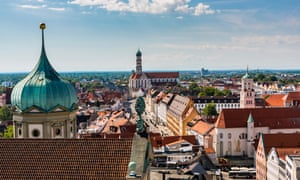 |
| Best of the ’burgs … Augsburg city skyline. Photograph: Alamy |
Riesling and Romans, baroque and bratwurst … our tipsters point to alluring cities from Bavaria to the Hanseatic northern ports – but sidestepping Berlin – taking in great food, museums, spas and bars
Winning tip: Augsburg
One of Bavaria’s oldest cities, Augsburg is a delightful base for a cycling journey on the “Romantic road” or a relaxed city break. Visit the Fuggerei, Europe’s most venerable social housing project, founded by the Fugger banking dynasty in the 16th century. Residents are charged only a nominal rent provided they attend mass daily – just as in the 1500s. The Brechthaus in the old artisan quarter of Lechviertel is the birthplace of Bertolt Brecht and offers insights into the great playwright, poet and director’s Augsburg youth, US exile and uneasy relationship with the GDR after eventually taking up residence in East Berlin. Enjoy hearty portions of knödel (dumplings) and spätzle (soft egg noodles) at Bauerntanz on Bauerntanzgasschen for around €25 a head. The Hotel Riegele, opposite the railway station, is comfortable, moderately priced (doubles €92 B&B) and a short stroll from the city centre.
Brian Weston
Brian Weston
EAST
Leipzig
A few years ago Leipzig suddenly became home to lots of creative and tech companies priced out of Berlin. If you add that to the fact it’s also a university town it’s no surprise it has fantastic bars (try the sour Gose beer on draft but you should drink it with Allasch, a sweet caraway liqueur, or it tastes awful) and coffee shops (Café Luise) is a favourite). But don’t overlook the stuff that’s been here years; visit the romantic and atmospheric Südfriedhof cemetery and if you’re here on a Friday at 6pm try to catch the Motette Thomaskirche (€2), an evening service and concert involving the superb boys choir at St Thomas church. It ends with a piece by Johann Sebastian Bach in recognition that he was the church’s cantor between 1723 and 1750.
Will K
Will K
Dresden
A wurst’s throw from the Czech border, Dresden isn’t the easiest city to get to but it’s one of Germany’s most rewarding. The old town, with its baroque skyline resurrected after the firebombing of 1945, is a dazzling cultural scene. You can roam for hours through the Dürers, Rubens and Raphaels in the Zwinger Palace(€10, daily) but for most bling for your buck visit the Grünes Gewölbe or Green Vault (€12, closed Tues), a treasury of gold, diamonds and crystals created by August the Strong in the 18th century. Then cross the Elbe for a walk through Neustadt, Dresden’s cool, grungier quarter, where Louisenstraße is full of eccentric bars, organic cafes and epic graffiti.
manofmode
manofmode
NORTH
Lübeck
Lübeck was last a big name German city in the 16th century – and it’s all the better for it. It’s a gorgeous Hanseatic city concocted from red brick, like Wigan but built by the Brothers Grimm. We spent our stay there swooning over the medieval warehouses, merchants’ residences and Gothic churches – fastidiously reconstructed after a wartime bashing. As literature fans we visited the homes of former residents Thomas Mann and Günter Grass. But most memorable for us was the famous Niederegger marzipan shop, where you can puzzle over the historical marzipan tableaux in the bizarre upstairs museum and try esoteric flavours such as plum and pineapple.
Morag Reavley
Morag Reavley
Hamburg
We had a wonderful trip to Hamburg earlier this year. If you want to see the city like a local I suggest you contact Hamburg Greeters who are members of the Global Greeter Network. They will arrange for a local to guide you on a tour of the city. This service is free, although you can make a donation to the organisation if you wish. You are asked to fill in a short questionnaire and are matched to a suitable volunteer guide. We spent an enjoyable four hours with Ulrich, who spoke perfect English and had a great sense of humour.
ID2333947
ID2333947
Brandenburg an der Havel
A short train ride from Berlin, Brandenburg is a different world. Dirty and industrial during the GDR period, it has now been cleaned up and is a beautiful low-key city full of history. There are medieval churches, a wonderful 12th-century Romanesque cathedral, humorous sculptures, a memorial to the victims of the Nazi era, and the opportunity for boat trips on the beautiful and extensive river and lakes nearby. The Werft restaurant (on the site of a former shipyard) overlooks the river and serves excellent food (Sunday brunch €20), including delicious vegetarian dishes.
BarbaraEF
BarbaraEF
SOUTH
Tübingen
The convivial university city of Tübingen enjoys a pretty location on the banks of the river Neckar. Half-timbered gorgeousness is everywhere, particularly along the river and around the Rathaus (town hall). In summer, the riverside Neckar campsite is the perfect place to stay: it’s leafy and quiet with good facilities and connected to the old town by a riverbank cycle path. One of the best places we found was the Neckarmüller Biergarten right by the river, where various beers are brewed that you can sample at long trestles under the trees, great with their giant pretzels. On the opposite bank of the Neckar from the campsite is a brilliant open air pool complex with slides and lots of grassy space for sunbathing.
Marthah
Marthah
Speyer
It was the sight of a Boeing 747 and a Concorde appearing to take off from the banks of the Rhine that caught our attention, just two of more than 2,000 exhibits in Speyer’s outstanding Technik Museum (from €8, daily). Not only did we climb aboard the Boeing, we were able to venture into the belly of a U-boat, explore a Russian Buran space shuttle and gawp at an impressive array of mechanical instruments and classic road, sea and air machines. We’d actually come to Speyer to see its 11th-century Romanesque cathedral! What a bonus this secular find was, superbly complementing the city’s ecclesiastical wonders.
fionachaillier
fionachaillier
Bamberg
Just over 30 minutes north of the historic city of Nuremberg by train lies the picture-postcard Bavarian town of Bamberg. It’s packed with half-timbered buildings and cobbled streets filled with artisan shops and bustling beer houses selling local, hearty fare. There are so many listed structures that Bamberg is a Unesco world heritage site. The former fishermen’s district in the island centre is known as Little Venice and you can even take a gondola ride (30-minute trip €60 for up to six people). But the Italian connection doesn’t stop there: like Rome, Bamberg was built on seven hills. Founded in 1787, Hotel Residenzschloss is on the banks of the river Regnitz and has doubles B&B from €94.
TxikiStu
TxikiStu
WEST
Trier
Germany’s oldest city, in the picturesque Moselle valley, claims to have more Roman remains than Rome! When you’ve explored the Porta Nigra Roman city gates, the baths, amphitheatre and bridge, there’s still plenty to do. The city centre, with its mix of medieval and renaissance architecture, is a delight. Pop into Kesselstatt wine bar (easily recognisable by its replica Roman wine ship outside) opposite the cathedral to try a selection of local rieslings. Then, to counter such decadence, visit the Karl Marx Museum for a no-holds-barred history of communism. It’s in the house where he was born in 1818 and is a big hit with Chinese tourists in particular. It is closed for renovation until May 2018, however.
ID6492793
ID6492793
Düsseldorf
Twenty minutes’ walk away from the bustle and party vibe of Alstadt’s narrow streets is a superb eatery, one of Dusseldorf’s trendiest. Pepella is an amazing Georgian restaurant that was opened in 2016 by three friends from Tbilisi. It has places for about 30 people, despite recently expanding into the cocktail bar next door. Try any of the aubergine dishes and the khachapuri (a cheese-filled bread) with a glass of Georgian wine. Afterwards go for a beer at nearby Suli’s or Loffelbar.
• Mains from €8.50, 30 Augustastrasse, pepella-duesseldorf.deleggkenny
• Mains from €8.50, 30 Augustastrasse, pepella-duesseldorf.deleggkenny
Wiesbaden and Mainz
Turn-of-the century spa architecture, hot springs, theatre and parks. Throw in a casino and lovely local rieslings and it’s easy to understand what brought the Kaiser, Fyodor Dostoyevsky and many artists and nobles to Wiesbaden and its surroundings. Take a ride in the Nerobergbahn 19th-century water-powered funicular, soak in the art nouveau thermal baths (Kaiser Friedrich Therme) and take walks in the hills around the city. Across the Rhine is Mainz, with its Roman history and medieval cathedral – as well as some excellent modern bistros – try Laurenz in the Neustadt district (mains from €16). Or hop on a train and explore the Rheingau wineries and monasteries just a few kilometres away. By the way, all of this is just half an hour away from Frankfurt airport.
motobu2003
motobu2003
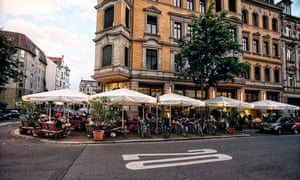
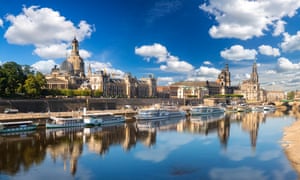
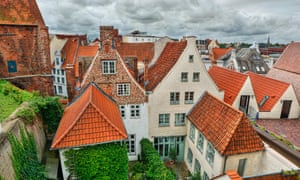

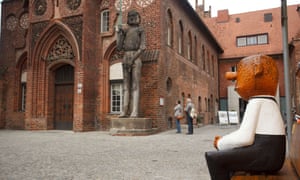
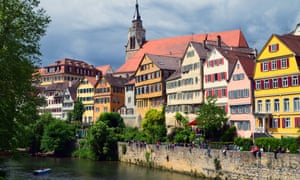
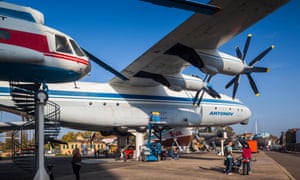
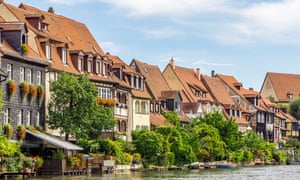

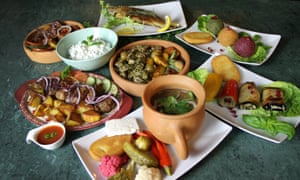
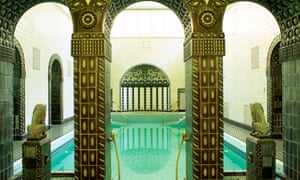
No comments:
Post a Comment